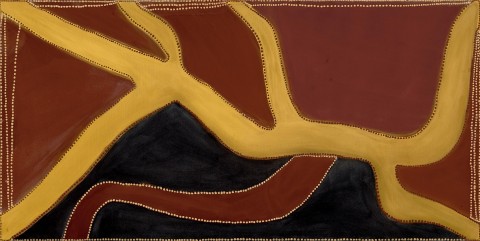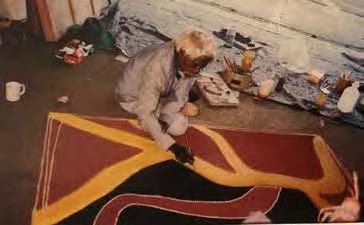TRIBUTARIES OF THE ORD RIVER, 1991
ROVER THOMAS (JOOLAMA)
natural earth pigments and bush gum on canvas
90.5 x 180.0 cm
signed verso: ROVER
Mary Macha, Perth
Vivien Anderson Gallery, Melbourne
Private collection, Melbourne
Deutscher~Menzies, Melbourne, 27 June 2000, lot 109
Private collection, Victoria
Lawson~Menzies, Sydney, 30 July 2002, lot 81
Private collection, Switzerland
Christie’s, London, 12 December 2007, lot 81
The Peter and Renate Nahum Collection of Aboriginal Art, London
On loan to the National Gallery of Victoria, Melbourne, and exhibited in the general collection between 2002 – 2006
Painted the year after Rover Thomas was the first Aboriginal artist to represent Australia at the Venice Biennale,1 Tributaries of the Ord River, 1991 is a robustly painted visual mnemonic of country well traversed by the artist in his days as a stockman in and around Texas Downs Station in the eastern Kimberley, towards the border with the Northern Territory.
By the time of the Venice exhibition, Rover Thomas was acknowledged as the leading artist of the Eastern Kimberley painting movement that emerged at Warmun (Turkey Creek) in the 1980s. The catalyst for this movement was the Gurirr Gurirr, a barlga or public ceremony that was revealed to the artist when he first settled at Warmun in the wake of Cyclone Tracy that destroyed the city of Darwin in 1974 and wreaked havoc across the east Kimberley. The barlga bears witness to that catastrophic event and incorporates references to sites of significance throughout the Kimberley. As the owner of the ritual Thomas did not paint designs on the boards carried by the performers as is customary, yet when he commenced his painting career in the early 1980s his intuitive, free-form renditions of the landscape, particularly evident in Tributaries of the Ord River, brought a fresh dynamism to the movement.
Ostensibly, Tributaries of the Ord River represents a map of water courses. The painting, however, is not a literal rendition of a geographic landscape. Typically, Rover Thomas overlays references to the ancestral past with the modern history of the eastern Kimberley, also incorporating a degree of autobiography. A number of the watercourses named by Thomas in describing this work may be difficult to find on conventional maps of the region, however they would be well known to stockmen who worked the area.
The Ord River is depicted laterally across the canvas flowing from the top left corner to the top right, towards Lake Argyle and on to Kununurra. Of the many rivers and creeks that flow into the Ord, Rover Thomas has depicted five which he identifies as, clockwise from the lower left: Dinah Creek; Tomato Creek in the upper centre left; Horseman River; Harvey Creek in the lower right; and Mistake Creek in the middle of the lower register of the composition. All are described in swathes of yellow ochre apart from the latter which stands out in red against a black ground, indicating its significance within the schema of the painting. Each element is bordered by lines of dots characteristic of the Eastern Kimberley style, and the whole image is also framed by dots as if to indicate the painting depicts a section of country or is part of a larger narrative.
Mistake Creek, that lies to the east of Texas Downs, evokes the Ngarrangkarni or Dreaming when the grassy lands around this stretch of river were subject to burning as represented by the surrounding black areas in the painting. It is also the site of a massacre of a group of Gija people along its shores in 1915, and where some years later another group sought refuge after a killing at Lajibany (Horseshoe Creek).
References to these tragic events in the early years of gardiya (European) settlement in the eastern Kimberley are a recurring theme in Rover Thomas’s oeuvre. Suites of paintings about this brutal aspect of Kimberley history are held in the collections of the National Gallery of Australia, Canberra, and the Janet Holmes à Court Collection, Perth.2 Thomas’ accounts of these harsh times, handed down orally over the decades, were never bitter or remorseful. He realised that these events were little known outside the region, yet they were stories that needed to be painted and in Thomas’ hands the painted landscape bears the evidence of all who walked upon it.
The Ord River itself is a historic reference point as well as a physical reality to the Gija, into whose society Rover Thomas had been adopted, and neighbouring groups in the eastern Kimberley. For millennia it was the main, life sustaining waterway that was dammed in the 1960s to create Lake Argyle as the reservoir for the irrigation scheme that transformed the landscape, and the lives of its Aboriginal inhabitants.
Tributaries of the Ord River has thematic and pictorial affinities with three paintings in the collection of the National Gallery of Australia: Lake Argyle, 1986, that depicts the Ord River; The camp at Mistake Creek, 1990;3 and the Texas Downs masterpiece All that big rain coming from top side, also painted in 1991.4
1. Along with the Adelaide born painter Trevor Nickolls (1949-2012)
2. For details of these paintings see Thomas, R. with K. Akerman, M. Macha, W. Christensen and W. Caruana, Roads Cross: The paintings of Rover Thomas, National Gallery of Australia, Canberra, 1994, and Carrigan, B., Rover Thomas: I want to paint, Holmes à Court Gallery, Perth, 2003
3. Thomas, R. et al, pp. 17 and 50, respectively
4. Cubillo, F. and W. Caruana (eds.), Aboriginal & Torres Strait Islander Art: Collection highlights, National Gallery of Australia, Canberra, 2010, p. 89
WALLY CARUANA

